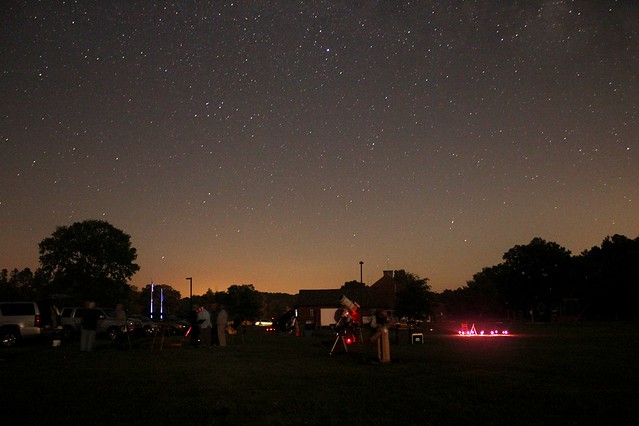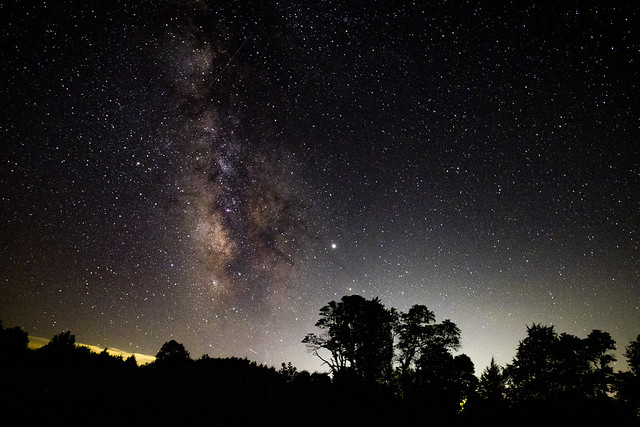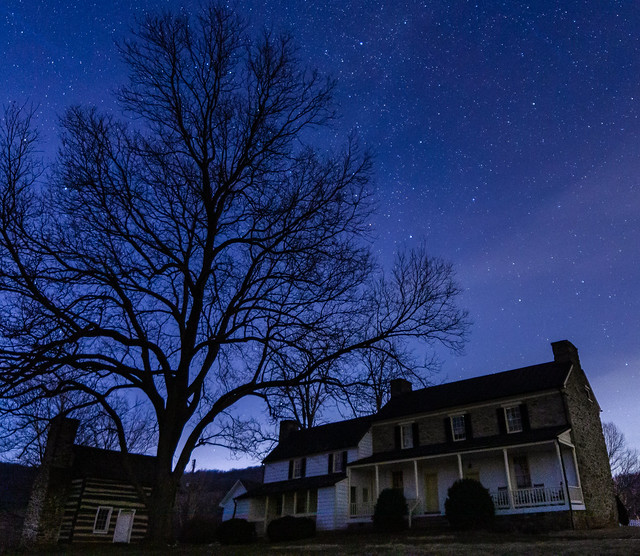Read Our Blogs
How to have the best stargazing adventure in Virginia State Parks
Looking for the best places to stargaze in Virginia State Parks? A good place to start is to visit one of our four state parks that are designated as International Dark Sky Parks — Staunton River, James River, Natural Bridge and Sky Meadows.
Dark Sky designation recognizes areas and organizations working to maintain spaces where the public can easily see the stars. In fact, a minimum requirement to be designated is that you can readily see the Milky Way with the unaided eye at designated dark sky parks.
The designation is not easy to get. Nighttime light pollution is common east of the Mississippi River, and natural nighttime darkness is disappearing, making stargazing more difficult. To ensure dark skies, dark sky parks must limit light pollution by only lighting what is necessary, pointing light downward as well as capping lights so that the light isn’t flooding the sky and using as dim of lights as possible.
Now that you know where we have internationally recognized dark skies, let me give you tips on where, when and how to have your best stargazing experience.
Plan your stargazing adventure

Photo by Johnathan Piques taken at Staunton River State Park
Wintertime
For the clearest and darkest nights, generally winter is the best time to go stargazing. Winter air holds less hazy moisture than balmy summer air. Long winter nights help get the sky fully dark long before kids’ bedtime as well, so the whole family can stargaze together.
The moon and weather
Though winter may be the most ideal for clear skies, Virginia State Parks hold stargazing programs throughout the year! If the cold isn’t for you, stargazing still can be, no worries. No matter what season you go stargazing in, you should look at a lunar calendar (aka moon phase calendar). The best moon phase to go stargazing at would be during a new moon – when the moon is invisible, that way you aren’t getting any moonlight. The full moon, while beautiful, is what you want to avoid if stargazing is your main goal, because its light will make it harder to see stars clearly.
You also want to check the weather before planning a stargazing adventure. Avoid nights with cloud coverage that would block the stars – some of the parks’ programs will still offer an astronomy educational presentation on cloudy nights, but some of the parks will cancel their events in the event of bad weather. Call the park in advance of your visit if you’re not sure.
Good things to bring
- Chair
- Binoculars or telescope for enhanced viewing
- Staunton River State Park lends out personal telescopes to visitors
- Astronomy events typically have telescopes for everyone to share
- A warm drink in a thermos
- Snacks
- Handwarmers
- A star chart
- Pick up a hard copy from a visitor center
- Download a star viewing app to use on your phone
- For photographers: your camera
- You can find some programs for photographers that teach you how to master astrophotography
- A head lamp with a red-light filter
- Red lights will still light your path and keep your eyes adjusted to the darkness for optimal stargazing
Stay overnight, for more than one night
Plan on more than one night stay, to increase your chances of a clear night sky. Many of the lodging amenities require a two or more night stay, anyway.
When, where and how at each International Dark Sky Park
More tips on how to have the best dark sky experience, below.
Staunton River State Park

Taken by Steve Andrews during Staunton River's Spring Star Party
WHEN:
Stay overnight: Make stargazing the easiest and most accessible by staying overnight. Good thing Staunton River has cabins, a bunkhouse and campsites -- even equestrian camping.
-
Camping season: the first Friday in March until the first Monday in December
Annual events to plan on: Every spring and fall Staunton River has annual star parties where you can camp out on the observation field for the week with other stargazers, astronomers and dark sky enthusiasts. Read this blog to learn more about these events.
- Spring 2025 Star Party (registration required): March 24-30, 2025
- Public Observation Night (free): March 25, 2025 at 8-10 p.m.
- Fall 2025 Star Party (registration required):October 20-26, 2025
- Public Observation Night (free): October 24, 2025 at 8-10 p.m.
WHERE:
Staunton River State Park’s designated observation area is conveniently right next door to their visitor center, you’ll see an open field when you enter the park. This is the best spot to post up without trees blocking your night sky.
If you want to visit the observation field outside of designated park programs, the park asks that you kindly give the park a call at (434) 572-4623 at least two days before visiting.
If you’re willing to hike to another great spot or are staying in a cabin near this area, I also suggest taking River Bank Trail to the “View of the Lake” lookout spot. Here you can see the beautiful confluence of the Staunton River and Dan River and look up at the sky from the water’s edge. This is an incredible spot to watch the sunrise or sunset, as well.
HOW:
Just visiting for a few hours? Park and pay the parking (admission) fee (self-pay options for when the contact station is closed). If you’ve booked a cabin or campsite, no need to pay for parking.
Don’t have your own telescope? The visitor center lends out telescopes to overnight visitors for free! Stop by the visitor center during the day (check their page for hours) to check one out. Don’t worry, a ranger will show you how to use it and provide supporting resources like a star chart.
James River State Park

You can see the Milky Way from James River State Park, as seen from this picture taken there
WHEN:
James River State Park works with local astronomy clubs to offer astronomy programs/star parties for you from early May through Labor Day. Click here to find astronomy programs you can attend at James River State Park.
Annual event: Don’t miss their annual two-night event that gathers astronomers, astronomy clubs and any interested visitors to stargaze together. Telescopes will be available; you may also bring your own.
- JRSP Star Party: check back for the fall date.
WHERE:
Stay overnight: James River State Park offers cabins, lodges (for large families or groups) and campsites. Camping season: primitive campsites open year-round, but full-service campsites open the first Friday in March to the first Monday in December.
The designated observation area at James River State Park is by shelter 4 and their amphitheater (click here for a map). For everyone’s safety, the park asks that unless you’re staying in a cabin or campsite, that this is the only place you visit during the night.
HOW:
Can you still go stargazing at the park without staying overnight or attending a stargazing program? Yes, you just have to call James River State Park (434-933-4395) in advance of your visit to request a special permit, which only costs the normal $5 parking fee. The parking tag will be ready for you to pick up at the visitor center. You are then allowed to be there from 10 p.m. till 2 a.m. for your stargazing adventure.
Natural Bridge State Park

The starry sky above Natural Bridge State Park
WHEN & HOW:
Spring through fall (and sometimes in the winter for celestial events) the park organizes special Dark Sky Nights. Because this park is mostly only a day-use park (with select primitive camping), the park sets aside Dark Sky Nights when the public is welcome after normal hours to go night sky viewing. Search the event database for upcoming events.
If you have interest in enjoying their dark skies outside of the Dark Sky Nights, call the park’s interpretation department at 540-254-0795 to coordinate a special permit to access the park.
WHERE:
Skyline Trail (click here for trail guide) is the best place in the park to look at the night sky. You will see the Blue Ridge Mountains in the distance.
Looking at Natural Bridge from Cedar Creek Trail can also be a delight at night, but only permitted on special occasions or with permit. Try going on a lantern tour or see the bridge illuminated with lights against a dark sky during an Illumination of the Bridge event. Click here for park events.
Sky Meadows State Park

A starry sky seen at Sky Meadows State Park
WHEN:
The park holds monthly astronomy programs, called Astronomy For Everyone, where astronomer volunteers guide visitors on a visual tour of the celestial skies and look at deep space objects through telescopes. These programs also provide educational outreach on the importance of light conservation. View event listings for upcoming astronomy programs.
WHERE & HOW:
For self-guided observation, the park has designated Turner Pond as its official Dark Sky Observation Area (click here for map of park). Here, astronomers and stargazers may practice astronomy after ordinary park hours. Please see the following guidelines for night sky viewing:
- Visitors may access the area any time of the day and after dusk. However, they must vacate the area by 2 a.m.
- Turner Pond is not available for overnight camping. Overnight camping must be done in accordance with our regular camping rules.
- Visitors must pay the regular $10 parking fee and display the yellow hang tag.
- Visitors must park in designated parking areas and walk to the “Viewing Field.”
More parks, more dark skies

Powhatan State Park offers dark sky events regularly
Even though the four parks mentioned above are internationally recognized, most other Virginia State Parks also have dark skies and take advantage of that by offering astronomy programs. There are many local astronomy clubs who support these stargazing events. Check the events page where you can click the REFINE LIST button to filter by Astronomy, Stargazing events to see even more opportunities to attend a program for stargazing.
If you have read the article and have a question, please email nancy.heltman@dcr.virginia.gov.
Search for blogs
By Park
Categories
Cabins
Camping
Fishing
History and Culture
Other
Programs and Events
Trails
Volunteers
Water Fun
Archive
2025
2024
2023
2022
2021
2020
2019
2018
2017
2016
2015
2014
2012














